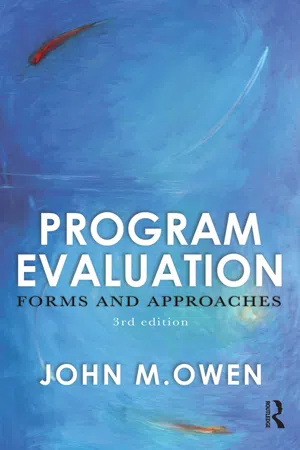
- 304 pages
- English
- ePUB (mobile friendly)
- Available on iOS & Android
About This Book
Program Evaluation 3rd edition has the hallmarks of thoroughness, insight and fluency of other editions but brings us up to date with a map of the evaluation territory new travelers will find invaluable.' Professor Murray Saunders, UK and European Evaluation Societies John Owen's Program Evaluation helps practitioners clarify distinctions between what we evaluate, the various motivations for conducting evaluation, and the approaches attendant to each. Timely evaluation examples liberally sprinkled throughout this book make it exceptionally useful and helpful to practitioners. I highly recommend Program Evaluation.' Professor Marvin Alkin, UCLA Graduate School of Education + Information Studies Everyone involved with policy and program development and delivery is being asked to plan more carefully, reflect more critically and justify their decisions. The key to this is evaluation. Program Evaluation offers a conceptual yet straightforward and practical overview of the evaluation process for both beginners and experienced practitioners. It shows evaluators how to identify appropriate forms, approaches and methods, using an original framework. John Owen examines the contributions of evaluation to program provision, and offers proven techniques for involving stakeholders in the planning process and for disseminating the evaluation findings.This third edition has been thoroughly revised to incorporate recent research on evaluation and new examples of good practice. It includes sections of management of evaluation, negotiating evaluation plans, program logic and ex ante evaluation, evidence based practice, performance management and accountability.With international examples from a range of health, education, welfare, community and other settings, Program Evaluation is an essential reference for anyone involved in evaluation in both the public and private sectors.
Frequently asked questions
Information
1
Evaluation Fundamentals
- may also see new directions for evaluation work; and can
- identify aspects of evaluation theory and practice that you wish to explore in more detail. This can be achieved by following up the relevant concepts and ideas through the references provided at the end of each chapter.
THE LOGIC OF EVALUATION
- What is the underlying basis for selecting criteria to judge the worth of each breakfast cereal?
- What evidence was used and on what standards was the judgment of worth made?
- How were the conclusions made and presented?
- Decision-making: you have been asked to recommend one brand of cereal to members of your household or to a friend. Which one will you choose?
Review
The ideal breakfast
What makes a good breakfast cereal?
| Brand/type (alphabetically within groups) | Category | Fibre (g/) all = per 100g | Fat (g/) | Sugars (g/) | Sodium (mg/) | Carbo (g/) | Energy (kj/cal/) |
|---|---|---|---|---|---|---|---|
| | |||||||
| Highly recommended (4% or less fat, 5% or less sugar, 7% or more fibre, 600 mg/100 g or less sodium) | |||||||
| HOME BRAND Wheat Biscuits | Biscuit | 12.2 | 2.7 | 2.3 | 270.0 | 64.5 | 1380/330 |
| KELLOGG’S Mini-Wheats Whole Wheat | Shredded wheat | 9.3 | 2.6 | 0.9 | 3.0 | 77.1 | 1523/363 |
| KELLOGG’S Wholegrain Wheat Flakes | Wheat-based | 11.0 | 1.1 | 2.0 | 468.0 | 81.3 | 1437/382 |
| SANITARIUM Lite-bix | ‘Light’ | 12.0 | 2.7 | 1.2 | 20.0 | 62.0 | 1340/320 |
| SANITARIUM Puffed Wheat | Wheat-based | 7.5 | 2.6 | 1.0 | 17.0 | 71.0 | 1440/344 |
| SANITARIUM Weet-Bix | Biscuit | 12.2 | 2.7 | 2.3 | 270.0 | 64.5 | 1380/330 |
| UNCLE TOBYS Organic Vita-Brits | Biscuit | 12.4 | 1.4 | 1.8 | 400.0 | 65.6 | 1320/315 |
| UNCLE TOBYS Shredded Wheat | Shredded wheat | 13.2 | 1.2 | 2.0 | 8.0 | 82.0 | 1330/318 |
| UNCLE TOBYS Wheeties | Wheat-based | 10.1 | 1.4 | 2.5 | 340.0 | 69.8 | 1390/332 |
| Recommended (9% or less fat, 19% or less sugar, 7% or more fibre, 600 mg/100 g or less sodium) | |||||||
| GOODNESS Tropical Toasted Muesli | Toasted muesli | 7.4 | 8.7 | 15.4 | 9.0 | 51.5 | 1569/375 |
| KELLOGG’S Just Right | Combination | 9.3 | 1.4 | 18.2 | 295.0 | 65.0 | 1534/381 |
| KELLOGG’S Mini-Wheats Apricot | Shredded wheat | 11.9 | 1.1 | 16.4 | 26.0 | 66.5 | 1503/358 |
| KELLOGG’S Sustain | Sports | 7.5 | 2.9 | 15.0 | 112.0 | 67.8 | 1607/399 |
| LOWAN Australian Rolled Oats (A) | Rolled oats | 11.5 | 8.7 | 1.2 | 6.3 | 65.3 | 1624/388 |
| MORNING SUN Natural Apricot and Almond Muesli | Natural muesli | 17.6 | 8.3 | 17.8 | 32.0 | 51.4 | 1420/339 |
| THE OLD GRAIN MILL Australian Gold Classic Muesli | Natural muesli | 12.2 | 8.7 | 19.3 | 46.0 | 46.7 | 1610/385 |
| THE OLD GRAIN MILL Australian Gold Natural Muesli | Natural muesli | 11.9 | 6.3 | 17.5 | 66.0 | 56.5 | 1548/370 |
| SANITARIUM Bran Bix | Biscuit | 22.0 | 4.4 | 5.7 | 410.0 | 45.0 | 1180/280 |
| SANITARIUM Crunchy Bix | Biscuit | 7.7 | 5.5 | 13.0 | 320.0 | 58.7 | 16/380 |
| SANITARIUM Natural Muesli | Natural muesli | 7.1 | 5.1 | 18.6 | 124.0 | 44.0 | 14... |
Table of contents
- Cover
- Title Page
- Copyright Page
- Contents
- Figures and tables
- Acknowledgments
- 1 Evaluation fundamentals
- 2 The nature of interventions: What we evaluate
- 3 Focusing evaluative enquiry: Evaluation forms and approaches
- 4 Negotiation and evaluation planning
- 5 From evaluation questions to evaluation findings
- 6 From evaluation findings to utilisation
- 7 Managing evaluation
- 8 Codes of behaviour for evaluators
- 9 Proactive evaluation
- 10 Clarificative evaluation
- 11 Interactive evaluation
- 12 Monitoring evaluation
- 13 Impact evaluation
- Index